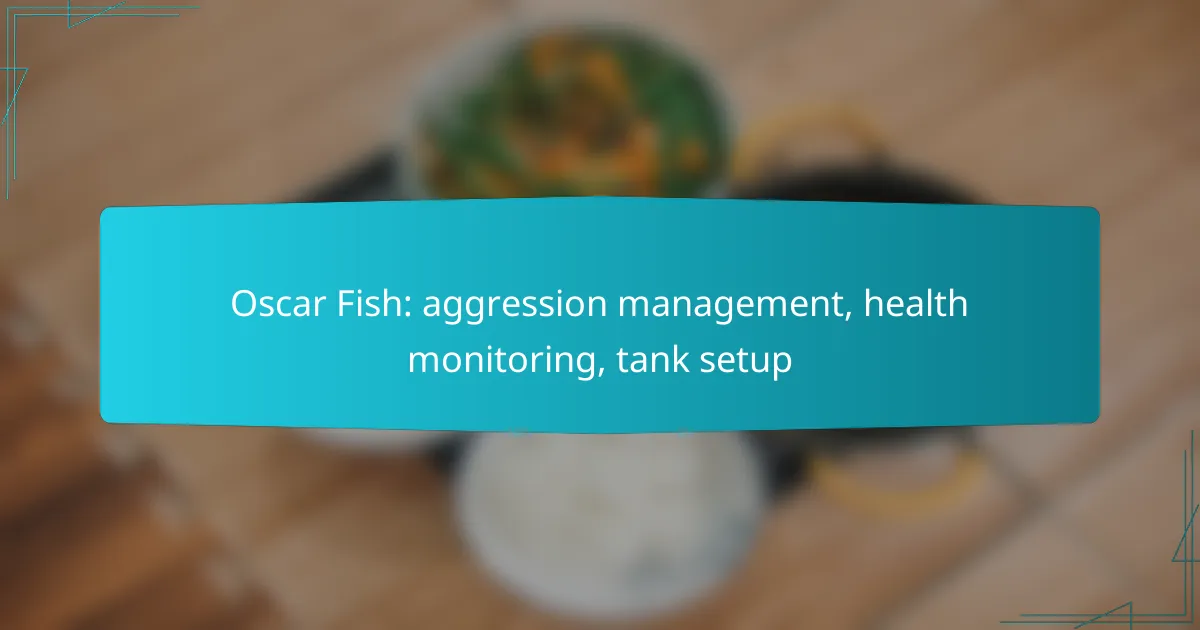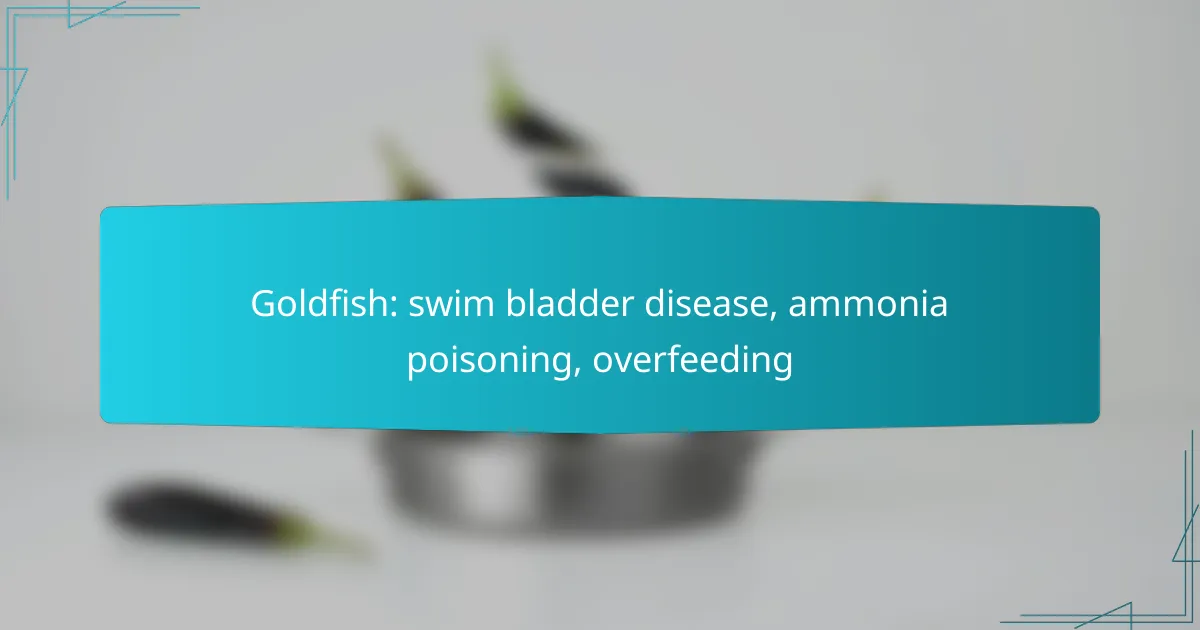Neon Tetras are vibrant and popular freshwater fish, but they can be susceptible to issues like ich disease and stress. Understanding how to treat ich effectively, recognize stress symptoms, and ensure proper tank compatibility is essential for maintaining their health and well-being. By taking proactive measures, aquarists can create a thriving environment for these beautiful fish.

How to treat ich disease in Neon Tetras?
Treating ich disease in Neon Tetras involves a combination of methods to eliminate the parasite and support the fish’s recovery. Effective treatments include using medications, adjusting water conditions, and isolating affected fish to prevent further spread.
Use of copper-based medications
Copper-based medications are effective against ich and can be found in various forms at pet stores. These treatments work by disrupting the life cycle of the parasite, making it unable to reproduce. Follow the manufacturer’s instructions carefully, as overdosing can harm your fish.
Monitor copper levels with a test kit to ensure they remain within the recommended range, typically around 0.2 to 0.5 mg/L. Regular water changes may be necessary to maintain water quality while treating.
Increase water temperature
Raising the water temperature can speed up the life cycle of the ich parasite, making it more susceptible to treatments. Aim for a gradual increase to about 28-30°C (82-86°F) over several hours. This temperature range is generally safe for Neon Tetras but should be monitored closely.
Keep in mind that higher temperatures reduce oxygen levels, so ensure adequate aeration in the tank. Avoid sudden temperature changes, as they can stress the fish further.
Salt treatment
Using aquarium salt can help treat ich disease by creating an inhospitable environment for the parasite. A common recommendation is to add 1-2 teaspoons of salt per gallon of water, but always dissolve it before adding to the tank to prevent harm to the fish.
Monitor your fish for any signs of distress, as some species may be sensitive to salt. It’s essential to perform regular water changes to maintain salinity levels and overall water quality.
Quarantine infected fish
Quarantining infected Neon Tetras is crucial to prevent the spread of ich to healthy fish. Set up a separate tank with similar water conditions and treat the affected fish there. This isolation period should last at least two weeks after visible symptoms have cleared.
During quarantine, continue monitoring the fish closely for any signs of stress or additional illness. This practice not only protects your main tank but also allows for more focused treatment of the infected individuals.
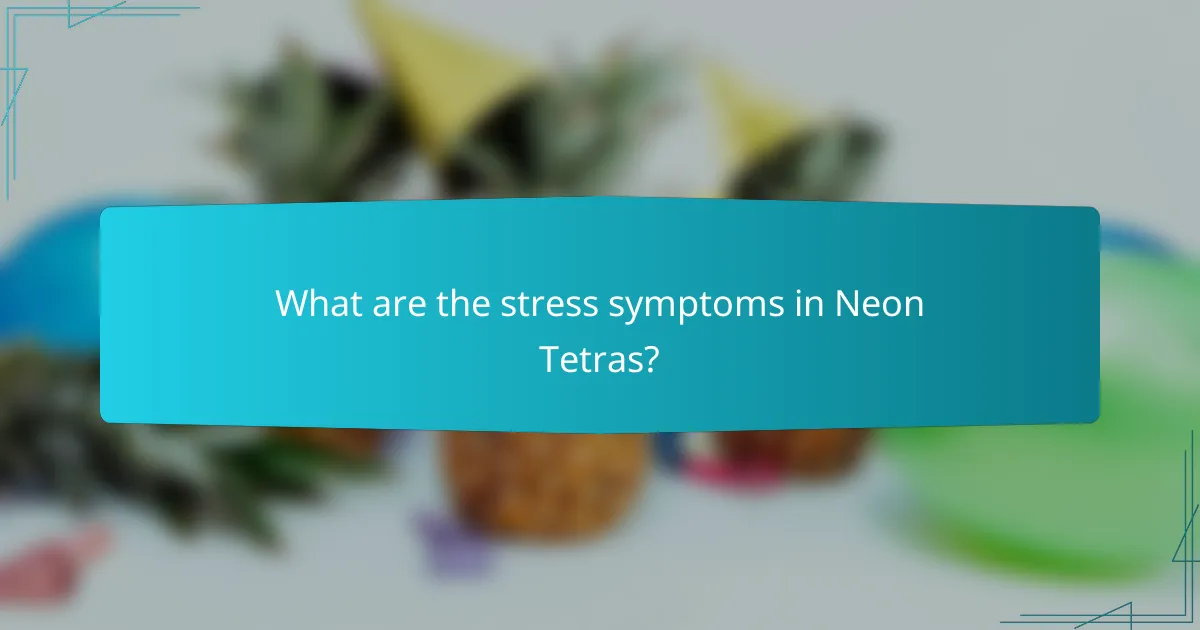
What are the stress symptoms in Neon Tetras?
Stress symptoms in Neon Tetras can manifest in various ways, indicating that the fish are experiencing discomfort or poor health. Recognizing these signs early can help prevent further issues and maintain a healthy aquarium environment.
Faded colors
One of the most noticeable stress symptoms in Neon Tetras is faded coloration. Healthy Neon Tetras display vibrant blue and red hues, but stress can cause these colors to dull significantly. This change often indicates underlying health issues or poor water conditions.
To address faded colors, check water parameters such as pH, ammonia, and nitrate levels. Ensuring a stable environment with proper filtration and regular water changes can help restore their vibrant appearance.
Erratic swimming behavior
Erratic swimming behavior is another common sign of stress in Neon Tetras. Instead of swimming calmly, stressed fish may dart around the tank, swim in circles, or hover near the surface. This behavior can be triggered by factors such as overcrowding, aggressive tankmates, or sudden changes in water conditions.
To mitigate erratic swimming, assess the tank’s population density and compatibility of species. Providing ample hiding spots and maintaining stable water conditions can reduce stress and promote more natural swimming patterns.
Hiding frequently
Frequent hiding is a typical stress response in Neon Tetras. When feeling threatened or uncomfortable, these fish may seek refuge in plants, decorations, or other sheltered areas of the tank. While some hiding is normal, excessive hiding can indicate significant stress levels.
To encourage more active behavior, ensure the tank is not overcrowded and that tankmates are non-aggressive. Adding more plants or decorations can provide a sense of security without causing excessive stress.
Loss of appetite
A loss of appetite is a critical stress symptom that can lead to serious health issues in Neon Tetras. When stressed, these fish may refuse food or eat very little, which can weaken their immune system and make them susceptible to diseases. This behavior can result from poor water quality, bullying from other fish, or illness.
To address loss of appetite, first check water quality and ensure it meets the appropriate standards. If water conditions are stable, observe the tank dynamics and consider separating aggressive fish or providing a more varied diet to entice feeding.

How to improve tank compatibility for Neon Tetras?
Improving tank compatibility for Neon Tetras involves selecting suitable tank mates, ensuring adequate space, and maintaining similar water conditions. These steps help create a harmonious environment that minimizes stress and promotes the health of your fish.
Choose peaceful tank mates
Neon Tetras thrive in peaceful communities, so it’s essential to select non-aggressive species as tank mates. Suitable companions include small, calm fish like guppies, rasboras, and other tetras. Avoid larger or territorial fish that may see Neon Tetras as prey or competition.
When introducing new fish, observe their behavior closely for signs of aggression or stress. A good rule of thumb is to keep the tank population balanced, ensuring that no single species dominates the space.
Maintain appropriate tank size
Neon Tetras require a minimum tank size of around 10 gallons to thrive, especially in groups of six or more. A larger tank provides more swimming space and helps dilute waste, which is crucial for maintaining water quality. For every additional tetra, consider increasing the tank size by a few gallons.
Overcrowding can lead to stress and health issues, so always calculate the total number of fish and their space requirements before adding new species to the tank.
Provide hiding spots
Creating hiding spots in the tank is vital for the well-being of Neon Tetras. They appreciate areas where they can retreat when feeling threatened or stressed. Use plants, rocks, and decorations to create sheltered spaces that mimic their natural habitat.
Live plants, such as Java moss or Anubias, not only provide cover but also contribute to water quality. Ensure that hiding spots are evenly distributed throughout the tank to give all fish access to safe spaces.
Ensure similar water parameters
Maintaining similar water parameters is crucial for the health of Neon Tetras and their tank mates. They prefer slightly acidic to neutral pH levels (around 6.0 to 7.0) and a temperature range of 22-26°C (72-78°F). Regularly test the water to ensure these conditions are stable.
When introducing new fish, acclimate them slowly to avoid shock. This can be done by floating the bag in the tank for about 15 minutes and gradually mixing tank water into the bag before releasing the new fish. This process helps ensure compatibility in water conditions and reduces stress during the transition.
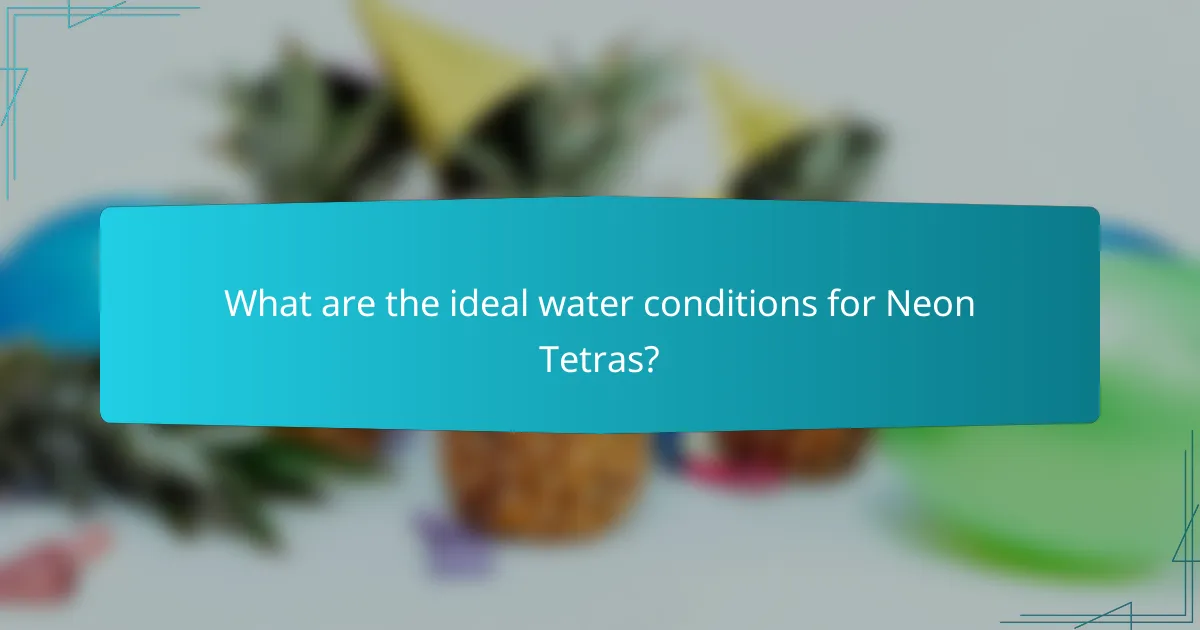
What are the ideal water conditions for Neon Tetras?
Neon Tetras thrive in specific water conditions that mimic their natural habitat. Maintaining the right pH, temperature, and water hardness is essential for their health and well-being.
pH level between 6.0 and 7.0
Neon Tetras prefer a pH level between 6.0 and 7.0, which is slightly acidic to neutral. Keeping the pH within this range helps prevent stress and promotes optimal health. Regular testing with a reliable pH meter or test kit can ensure that the water remains stable.
A sudden change in pH can lead to stress or illness, so gradual adjustments are recommended if changes are necessary. Aim to check the pH at least once a week to maintain consistency.
Temperature range of 72-78°F
The ideal temperature range for Neon Tetras is between 72°F and 78°F (22°C to 26°C). This temperature range supports their metabolic processes and overall activity levels. Using a reliable aquarium heater can help maintain a stable environment.
Fluctuations outside this range can lead to stress, making the fish more susceptible to diseases. Monitor the temperature regularly, especially during seasonal changes, to ensure it remains within the preferred range.
Soft water preference
Neon Tetras thrive in soft water, typically with a hardness of 2 to 10 dGH. Soft water mimics their natural habitat in the Amazon basin, where they are commonly found. Using a water conditioner or reverse osmosis system can help achieve the desired softness.
Hard water can lead to stress and health issues, so testing for water hardness is crucial. If your tap water is hard, consider mixing it with distilled water to create a suitable environment for your Neon Tetras.
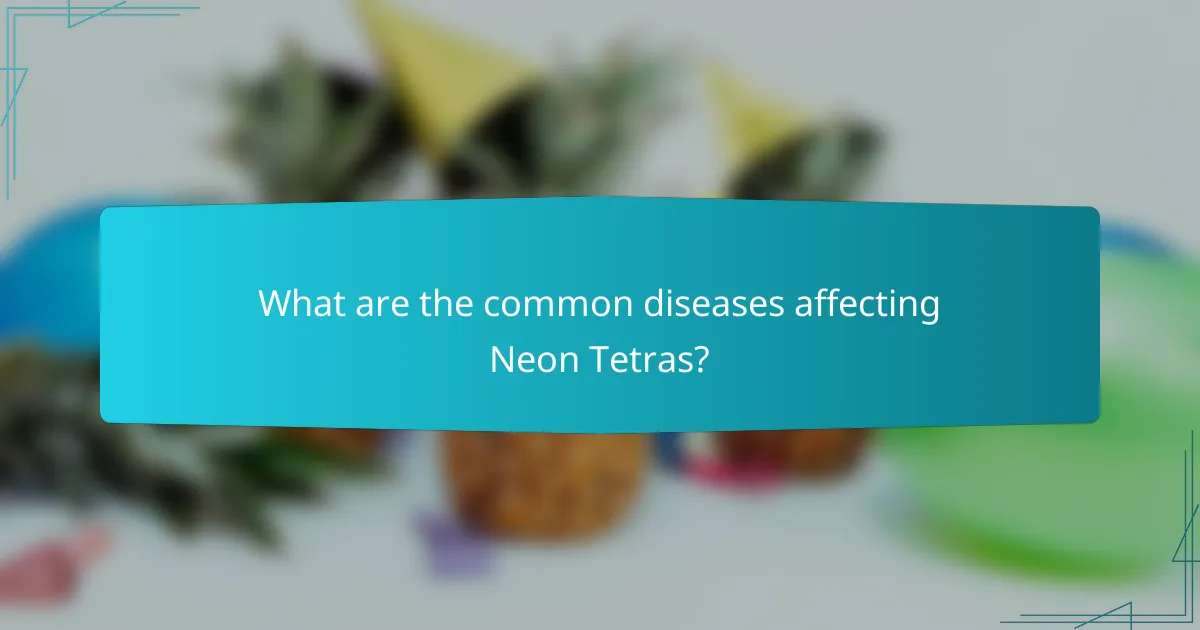
What are the common diseases affecting Neon Tetras?
Neon Tetras are susceptible to several diseases, with Ichthyophthirius multifiliis (Ich) and fin rot being among the most common. Understanding these conditions can help in early detection and effective treatment, ensuring the health of your fish.
Ichthyophthirius multifiliis (Ich)
Ich, caused by the parasite Ichthyophthirius multifiliis, is a highly contagious disease that manifests as white spots on the skin and fins of Neon Tetras. It thrives in poor water conditions, making tank maintenance crucial for prevention.
To treat Ich, raise the water temperature gradually to around 28°C (82°F) and use a suitable medication, often available at pet stores. Ensure you follow the dosage instructions carefully to avoid harming your fish.
Regular water changes and maintaining good filtration can help prevent outbreaks. Monitor your fish for signs of stress, as weakened immune systems can increase susceptibility to this disease.
Fin rot
Fin rot is a bacterial infection that leads to the deterioration of the fins and tail of Neon Tetras, often resulting from stress or poor water quality. Symptoms include frayed or discolored fins, which can worsen if left untreated.
To treat fin rot, improve water conditions by performing frequent water changes and using a broad-spectrum antibiotic as directed. Quarantine affected fish to prevent the spread of bacteria to healthy ones.
Preventing fin rot involves maintaining stable water parameters, providing a balanced diet, and minimizing stressors such as overcrowding or aggressive tank mates. Regularly inspect your fish for early signs of fin damage to address issues promptly.








